The Governance and Infrastructure in the Amazon Project is led by the University of Florida Tropical Conservation and Development Program and aims to create, strengthen and expand a Community of Practice and Learning (CoP-L) for exchanges of experiences and reflection on the use of tools and strategies for infrastructure governance by conservation and development practitioners in the Amazon.
Infographic Report on Timelines of Infrastructure and Environmental Governance
Compilation of events and processes that have occurred over time allows us to understand changes in governance of infrastructure. The GIA project supported creation of timelines in four regions of the Amazon at our 2019 workshops with conservation partners in Loreto (Peru), the Upper Madera (Bolivia-Brazil), Southern Amazonas/Northern Rondonia (Brazil), and the Colombian Amazon (Colombia). In each workshop, participants identified and discussed key events relevant to governance and infrastructure. From the workshop timelines, the GIA team created analytical timelines in a common format and produced a report that looks at common themes, factors that facilitate or impede good governance, lessons learned, and emergent questions.
The analytical timelines focus on the period from 2000 to 2019. These timelines differentiate between events and processes operating on different scales, from the local to the international. They also differentiate among types of events and processes, including public policies, infrastructure projects, infrastructure impacts, environmental setbacks, and collective action.
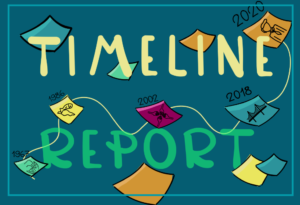
We view timelines as a tool to stimulate reflection and discussion about governance of infrastructure in the Amazon. The timelines provide the basis for identification of factors that facilitate and impede environmental governance in the context of infrastructure.
Factors that facilitate governance include 1) recognition of common interests among stakeholders, 2) decentralized decision-making, 3) collaboration across scales among stakeholders, 4) supportive governmental agencies willing to work with other stakeholders, and 5) collective management of natural resources.
Factors that undermine governance include 1) lack of broad stakeholder participation, 2) inconsistency in national governmental policies from one election to another, 3) lack of transparency in decision-making, 4) politicians who are unsympathetic to social-environmental concerns, and 5) stakeholders who react to conservation threats instead of planning ahead.
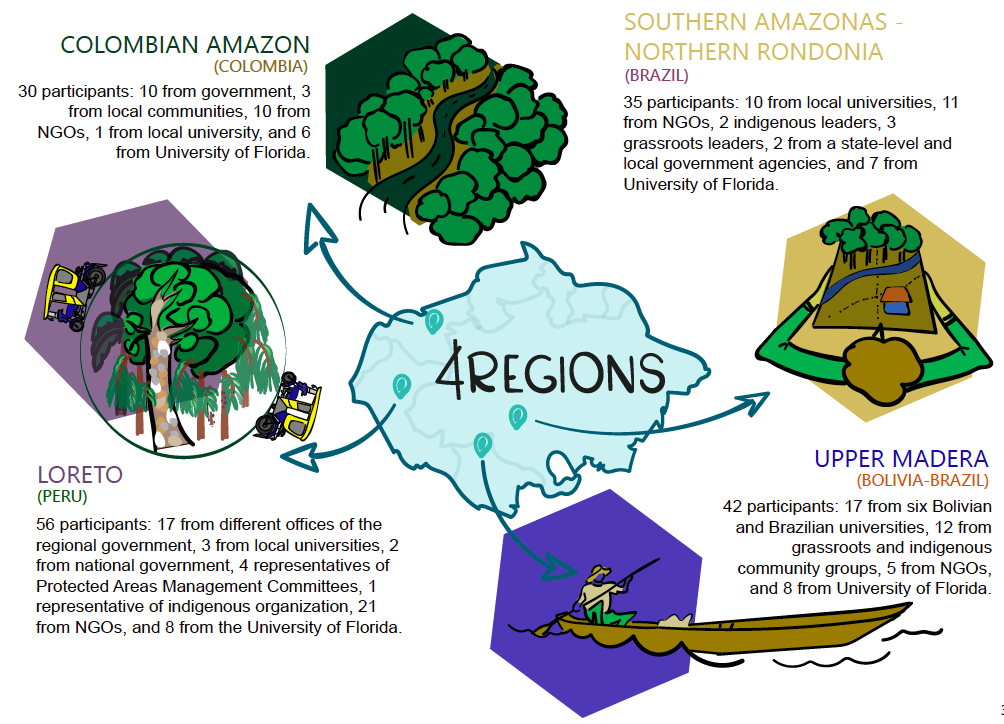
Timelines for focal mosaics revealed distinct insights. In Colombia, the peace process has led to new threats to forests and indigenous peoples, but also to debate about green infrastructure. In Southern Amazonas/Northern Rondonia, federal policies are crucial for both infrastructure planning and environmental governance, but governments have consistently favored the first and not the second. In Loreto, Peru, decentralization and collaboration among regional stakeholders advanced environmental governance for several years, but those gains are now threatened due to governmental change. In the Upper Madera, a bi-national frontier, governments have secured international agreements to build dams but have not provided for governance, which motivated grassroots organizing of social movements to resist.
Viewed together, the timelines permit more general conclusions. First, national governments consistently support infrastructure over time and across countries. Second, governmental concern about conservation has varied over time, undermining environmental governance. Third, conditions for effective environmental governance change over time, depending in large part on changes in governments. And fourth, horizontal as well as vertical (cross-scale) collaboration is a key strategy to advance environmental governance. Finally, the timelines provide lessons for strategies to advance environmental governance of infrastructure. Bottom-up approaches are more effective when 1) investments in capacity building shift the balance of power among stakeholders, 2) stakeholders identify shared interests, 3) stakeholder interest in data for policy is supported by powerful constituencies, and 4) local and regional governments support other stakeholders.
Please download a copy of the infographic timeline report in English, Portuguese or Spanish, which you are welcome to share with local partners. We also welcome feedback and discussion.
Colombian community leaders partnering with GIA research
We are proud to introduce four inspiring local collaborators who will team up with Dr. Jazmin Gonzales Tovar and Dr. Martha Rosero Peña in their post-doctorate research projects related to GIA.
Martha’s research on “Effective collaborative relationships and infrastructure challenges” seeks to learn lessons from collaborative environmental governance efforts carried out among local communities, indigenous peoples and NGOs in the Colombia mosaic. This research seeks to understand how internal and external factors such as culture, organizational strategy, capacity, political factors and institutional relationships affect partnerships, and the practices that organizations and local and indigenous people have used to navigate collaboration. Martha will work jointly with Flora Macas and Waira Jacanamijoy, two indigenous Inga who are part of the Association of Cabildos Tandachiridu Inganokuna. As co-researchers, they will be talking with traditional authorities and leaders on the aspects that are key for an effective collaborative relationship between institutions and indigenous peoples. The result of their research will be recommendations drawn from an indigenous perspective about elements that are crucial for the parties involved in fostering productive collaborative relationships.
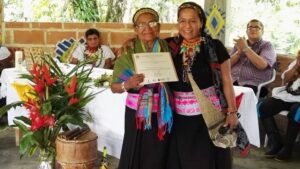
Waira Jacanamijoy (on the right of the photo). “My experience is based on supporting local processes, such as the formulation of comprehensive indigenous public policies in the department of Caquetá, and the creation of the Round Table of Indigenous Consultation.” Please click here to access her testimony.
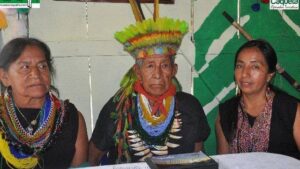
Flora Macas (On the right of the photo). “Traditional Medicine has been the guide, the mandate, and the force that has conducted my life.” Please click here to access her testimony.
Jazmin’s research on “Effectiveness of conservation strategies for infrastructure governance,” aims to assess how power, political mobilization, collaboration, and the governance context influence the effectiveness of conservation strategies to promote infrastructure governance. This research will comparatively analyze an emblematic case in each of the four mosaics: Colombia, Bolivia, Brazil, and Peru. For the case of Colombia, Jazmin is in direct collaboration with Nidia Becerra. Nidia is an indigenous Inga and leader from Yunguillo, an indigenous resguardo known for its constant fight for their rights. Nidia will be the key link with the communities that are part of the resguardo and will dialogue with the traditional and spiritual authorities and leaders to deeply explore how Yunguillo people faced road projects, how they interacted with other actors, what were the results and why. This research aims to produce scientific evidence and communication materials that help Yunguillo people in their lucha.
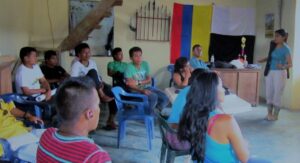
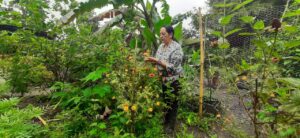
Nidia Becerra. Ex-Governor of the indigenous Inga resguardo of Yunguillo (Putumayo-Cauca) and part of the Council of Wise-Elderly, which is the highest traditional authority of the cabildo, a position that is occupied for life. “I have seen Yunguillo communities and authorities in a constant fight for reclaiming individual and collective rights, saving the lives of community members and their territory, in the middle of crossfires and violent massacres. Those are moments that I will never forget. That is why I always knew that I would dedicate my life to the defense of communities and territories.” Please click here to access her testimony.
Both research projects will have the support of Lucy Etnith Román as field assistant. She will be in charge of the organizational and administrative aspects of research implementation. “I was educated as a Community Health Promoter, Nursing Technician and Executive Secretary. This knowledge allows me to work in support of indigenous and campesino communities (mainly children and Youth).” Please click here to access her testimony
We hope that all the GIA research projects contribute to strengthening the strategies of our partners to face the challenges of infrastructure governance in the Amazon.
Learn more about news and events in the GIA Focal Mosaics!
GIA partners and others have organized an avalanche of interesting and valuable webinars and other online events. Here we share brief reports on just a few of these important discussions.
La Mula Verde #8: Acuerdo Escazú,
June 10th
Organized by: CITA – UTEC
Description: Interview with Dr. Mariano Castro about the Escazú Agreement. Access the video here.
Democracia ambiental ahora: Acuerdo de Escazú y defensores ambientales, June 16
Organized by: SPDA
Description: International and national experts met to address the situation of environmental defenders and the Escazú Agreement. Access the video here.
Loreto (Peru)
Ríos danzantes de la amazonia peruana, June 3rd
Organized by:CITA – UTEC
Description: The”Ríos Danzantes” online platform contains research by CITA-UTEC about the Marañón, Huallaga, Ucayali and Amazonas rivers. It contains information on the river’s role as a source of biodiversity, methods used, and a Data Map with the information obtained from the multi-temporal analysis of satellite images and field measurements. Access the video here.
Justicia Ambietal y Día Del Ambiente,
June 5th
Organized by: MINAM, GEA, DAR, SPDA, ACCA, Facultad de Derecho – PUCP
Description: This was a full day of presentations: “Compras publicas en la economia circular en el marco de la Directiva de Ecoeficiencia del Poder Judicial,” “El acuerdo de Escazú y la Justicia Ambiental,” “Retos de la Justicia Ambiental en el Peru,” “Cloud Computing y Big Earth Data al servicio de la Justicia Ambiental,” y “Aportes de las Clínicas Jurídicas Ambientales a la Justicia Ambiental.” Access the video here.
Colombian Amazon
Forestería Comunitaria, June 9th
Organized by: FCDS
Description: Experts working with local communities in the Colombian Amazon explained the challenges and opportunities to strengthen community forest management. They shared experiences of FCDS, Corazón Amazonia, ONF Andina, and FAO UN-REDD. Access the video here.
Conmemoración 25 años OPIAC, June 10th
Organized by: OPIAC
Description: The 25 year history of the National Organization of the Indigenous Peoples of the Colombian Amazon – OPIAC was celebrated and shared online. Access the video here
Southern Amazonas/Northern Rondonia (Brazil)
On June 5th, RECAM organized a webinar to discuss the challenges of the COVID-19 pandemic and the strategies that socio-environmental organizations are using to support communities, traditional peoples and family farmers in the Amazon, so that they do not become even more vulnerable, including campaigns to donate kits of food, hygiene and general-purpose products, emergency support for local product commercialization, technical advice by phone and message applications, and information generation and awareness about threats to health and territories.
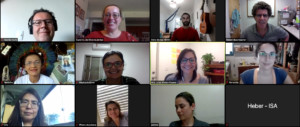
It also addressed opportunities for generating positive long-term structural changes, such as the regionalization of production and commercialization, shortening national and global food and health supply chains. The challenge and opportunities for incorporating health more centrally within social and environmental discussion was also raised. Some questions remained for further reflection: What is the new development paradigm that we want? And how can we search for new paths at a time of weakening democracy and social and environmental setbacks, such as increased deforestation in the Amazon?
The RECAM Network (Rede de Capacitação da Amazônia, in Portuguese) is a Brazilian multi-organizational network that was created in 2013. The members include mostly regional and national non-governmental organizations (NGOs) that work in the Amazon, but also universities, funding agencies, a private foundation, and a state government program. RECAM was created with the idea of exchanging experiences related to environmental governance and capacity building, but with time has expanded its role and themes of interest. UF/TCD has been a part of the network since its beginning and this year is the facilitator organization. There are many complementarities between GIA and RECAM, and we invite GIA partners to participate in future RECAM discussions and activities. Visit RECAM page on Facebook here.
The Amazon and the dismantling of Brazilian public environmental policies, May 23rd
Organized by: Eduardo Moreira web channel
Description: The researchers Juliana Santiago (University of Florida); Erika Berenguer (Oxford University); Raoni Rajão (Federal University of Minas Gerais) and Senator of the Republic Fabiano Contarato debate with Eduardo Moreira the challenges for the conservation of the Brazilian Amazon in the face of the dismantling of public environmental policies by the Bolsonaro government and the pandemic of COVID-19. The speakers expressed how much Brazil had progressed and positioned itself as a protagonist in the discussion of public policies necessary to mitigate climate change, especially those related to land use and the reduction of deforestation, and highlighted the risk of losing this leadership, given the recent dismantling of public institutions and policies. Mobilization and political will are necessary to reestablish participatory governance, with multiple stakeholders, who with their respective perspectives, resources and roles, can reestablish the path towards a more developed Brazil, with social justice and environmental protection. Access the video here.











